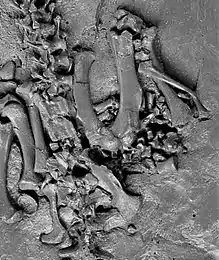Euromanis
Euromanis ("european pangolin") is one of the earliest known pangolin genera. It lived during the Eocene in Europe. Euromanis fossils found in the Messel Pit in Germany. Unlike modern pangolins, it did not bear scales on its body.[3][1]
| Euromanis | |
|---|---|
 | |
| Fossil of Euromanis krebsi | |
| Scientific classification | |
| Kingdom: | Animalia |
| Phylum: | Chordata |
| Class: | Mammalia |
| Order: | Pholidota |
| Genus: | †Euromanis Gaudin, 2009[1] |
| Type species | |
| †Euromanis krebsi Storch & Martin, 1994[2] | |
| Synonyms | |
|
synonyms of speacies:
| |
Phylogeny
Phylogenetic position of genus Euromanis within order Pholidota.[1][4]
| Pholidotamorpha |
| |||||||||||||||||||||
(Pholidota sensu lato) |
References
- Gaudin, Timothy (2009). "The Phylogeny of Living and Extinct Pangolins (Mammalia, Pholidota) and Associated Taxa: A Morphology Based Analysis" (PDF). Journal of Mammalian Evolution. Heidelberg, Germany: Springer Science+Business Media. 16 (4): 235–305. doi:10.1007/s10914-009-9119-9.
- Storch G, Martin T (1994) "Eomanis krebsi, ein neues Schuppentier aus dem Mittel-Eozän der Grube Messel bei Darmstadt (Mammalia: Pholidota)." Berliner geowiss Abh E13:83–97
- Horovitz, Inés; Gerhard Storch & Thomas Martin (2005). "Ankle structure in Eocene pholidotan mammal Eomanis krebsi and its taxonomic implications" (PDF). Acta Palaeontol. Pol. 50 (3): 545–548.
- Kondrashov, Peter; Agadjanian, Alexandre K. (2012). "A nearly complete skeleton of Ernanodon (Mammalia, Palaeanodonta) from Mongolia: morphofunctional analysis". Journal of Vertebrate Paleontology. 32 (5): 983–1001. doi:10.1080/02724634.2012.694319. ISSN 0272-4634.
This article is issued from Wikipedia. The text is licensed under Creative Commons - Attribution - Sharealike. Additional terms may apply for the media files.